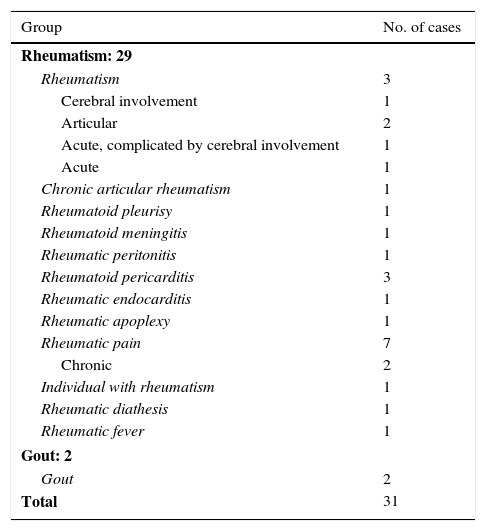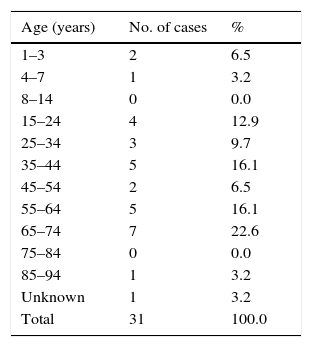A total of 26,203 of the deaths in Jerez de los Caballeros (Badajoz) during the 19th century were collected and grouped according to the Bertillon's classification, in order to study the causes of death from rheumatic diseases. An analysis was made using the death registers, those located in the Parish archives, and files of the municipal archives. There were a total of 31 deaths due to rheumatic diseases, with the 65–74 years age group being most frequent. The lack of records may be due to the inaccuracy of the diagnoses. September was the month of increased mortality.
Se han recopilado 26.203 defunciones en Jerez de los Caballeros (Badajoz) durante el siglo xix, agrupándolas según la clasificación de Bertillon, para estudiar las causas de muerte por enfermedades reumáticas, mediante el análisis de los Libros de Defunción del Archivo Parroquial y legajos del Archivo Municipal. Se halla un total de 31 fallecidos, siendo el segmento entre 65–74 años el que presenta las mayores cifras. La escasez de registros puede ser debida a la inexactitud de los diagnósticos. El mes con mayor mortalidad es septiembre.
The information is processed in accordance with the Third International Classification of Diseases published in 1899 by Jacques Bertillon. He defined the rules that should be followed to settle any doubts that arise when classifying the causes of death.1
This classification serves as a model for the subsequent revisions issued by the International Classification of Diseases (ICD), and is the system most widely utilized by medical historians. Its application has countless advantages, such as the fact that it is used worldwide, a feature that enables comparisons among different countries.2
The methodological problem concerning how to undertake the analysis of mortality (the retrospective diagnosis) on the basis of the diagnostic terms that can be gleaned from entries in the death records found in parish and municipal archives is approached using semantic analysis of document collections. This approach poses a series of difficulties.3
The objective is to study the causes of death due to rheumatic diseases in Jerez de los Caballeros, a town in southwestern Spain, in the province of Badajoz, during the 19th century. This subject has scarcely been dealt with or studied from the rheumatologic perspective, the reason for which it is important to these specialists.
Material and MethodsWe analyzed the parochial archives of Jerez de los Caballeros (PAJC), which houses the death records of the 4 local parishes. Together, they compile 26,203 deaths; the cause of death is not mentioned in 7665, whereas, in 18,538, it is. In his study of the population of Seville in the 19th century, Álvarez Santaló wrote, “The parochial records are the true basis and the reason for this study”.4
ResultsWe found the records of a total of 31 deaths, 0.1% of all the deaths in the population. Rheumatic diseases are addressed in points 26 and 27 of section 2 of Bertillon's classification, entitled “Other general diseases”(Table 1).
Rheumatic Diseases in Jerez de los Caballeros During the 19th Century.
| Group | No. of cases |
|---|---|
| Rheumatism: 29 | |
| Rheumatism | 3 |
| Cerebral involvement | 1 |
| Articular | 2 |
| Acute, complicated by cerebral involvement | 1 |
| Acute | 1 |
| Chronic articular rheumatism | 1 |
| Rheumatoid pleurisy | 1 |
| Rheumatoid meningitis | 1 |
| Rheumatic peritonitis | 1 |
| Rheumatoid pericarditis | 3 |
| Rheumatic endocarditis | 1 |
| Rheumatic apoplexy | 1 |
| Rheumatic pain | 7 |
| Chronic | 2 |
| Individual with rheumatism | 1 |
| Rheumatic diathesis | 1 |
| Rheumatic fever | 1 |
| Gout: 2 | |
| Gout | 2 |
| Total | 31 |
Rheumatic disorders created problems when it came to the differential diagnosis with gout, since “…many authors see a true parallelism between these 2 diseases, the only difference being that the term “rheumatism” is reserved for cases involving the large joints, and the term “gout” is used to indicate that the same principle is applied to small joints”.5
Table 2 shows the different age groups. The infants and small children are grouped from 1 to 3 years and from 4 to 7 years, respectively6; a third group was formed by older children and adolescents ranging in age from 8 to 14 years; thereafter, each group of adults spans a period of 10 years.
Rheumatic Diseases by Age.
| Age (years) | No. of cases | % |
|---|---|---|
| 1–3 | 2 | 6.5 |
| 4–7 | 1 | 3.2 |
| 8–14 | 0 | 0.0 |
| 15–24 | 4 | 12.9 |
| 25–34 | 3 | 9.7 |
| 35–44 | 5 | 16.1 |
| 45–54 | 2 | 6.5 |
| 55–64 | 5 | 16.1 |
| 65–74 | 7 | 22.6 |
| 75–84 | 0 | 0.0 |
| 85–94 | 1 | 3.2 |
| Unknown | 1 | 3.2 |
| Total | 31 | 100.0 |
Logically, the majority of the rheumatic disorders were found in individuals over the age of 34 years, although there were 3 deaths in children under the age of 8 years. The latter were undoubtedly the results of errors in the diagnosis or in the nomenclature on the part of the physicians or priests who were in charge of entering the information in the death records.
September was the month with the highest mortality rate (8 deaths, 25.8%), the end of summer and the autumn months being the period during which the greatest number deaths occurred (n=19, 61.3%). However, taking into account all of the diseases in Jerez during the 19th century, the season with the highest rate of all-cause mortality was summer.7
DiscussionMany authors have studied parochial records. In reports dealing with the pre-statistics era, their importance is exceptional. However, the quality or reliability of these records is still a question of debate.
Rheumatic diseases were responsible for a very small percentage of all the deaths in the population of Jerez throughout the 19th century. This fact may be due to the diagnostic difficulties faced by the professionals of that period. The finding of children among the dead supports this assertion. Although there have been references to rheumatic diseases for thousands of years, it is during the 20th century that they begin to be described accurately and in detail.8 Together, these circumstances might explain the paucity of registers during the study period, when diagnoses were very inexact and vague and the reported causes of death were often the signs or symptoms rather than the diseases themselves.
Comparing our results with those of other nearby populations, we confirmed that in Badajoz, the capital city, between 1871 and 1880, 23 deaths related to rheumatic diseases were reported, out of a total of 9312, that is 0.25%.9 Meanwhile, in Almendralejo, a city in the same region, out of 26,837 deaths registered during the entire 19th century, only 21 involved cases of rheumatism and 2, of gout (0.1%).10 With respect to another town, in Badajoz, Villanueva del Fresno, near the border with Portugal, the author reports 6394 deaths between 1800 and 1870, barely 0.02% of which were associated with rheumatism.11 We have another example in Llerena, in the south of the province, where, again between 1800 and 1870, there were 5 cases of rheumatism and 1 of gout out of 11,659 deaths (0.05%).12 Finally, in the town of Los Santos de Maimona, in the center of the province, out of a total of 29,885 recorded deaths, 22 were associated with rheumatism and 3 with gout (0.1%).13 As shown by these reports, with numbers of deaths similar to ours, the results were identical, whereas, with the exception of Badajoz, wherever there was a lower number of deaths, the percentage associated with rheumatism was markedly lower. We should point out that, in the reports involving fewer cases of rheumatic disease, the time span was also shorter. Therefore, the objective of future studies could be to extend the time period and determine whether the incidences are similar to ours.
Ethical DisclosuresProtection of human and animal subjectsThe authors declare that no experiments were performed on humans or animals for this study.
Confidentiality of dataThe authors declare that they have followed the protocols of their work center on the publication of patient data.
Right to privacy and informed consentThe authors declare that no patient data appear in this article.
Conflicts of InterestThe authors declare they have no conflicts of interest.
Please cite this article as: Peral Pacheco D, Suárez-Guzmán FJ. Causas de mortalidad por enfermedades reumáticas en Jerez de los Caballeros (Badajoz) durante el siglo xix. Reumatol Clin. 2016;12:78–80.








